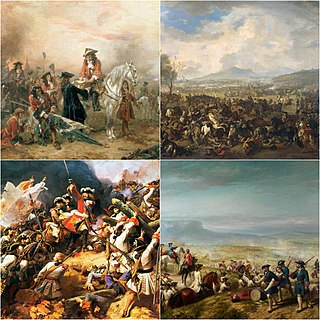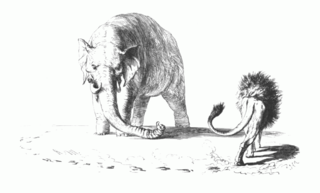
The War of the Polish Succession was a major European conflict sparked by a Polish civil war over the succession to Augustus II of Poland, which the other European powers widened in pursuit of their own national interests. France and Spain, the two Bourbon powers, attempted to test the power of the Austrian Habsburgs in Western Europe, as did the Kingdom of Prussia, whilst Saxony and Russia mobilized to support the eventual victor. The fighting in Poland resulted in the accession of Augustus III, who in addition to Russia and Saxony, was politically supported by the Habsburgs.

The War of the Spanish Succession was a European great power conflict fought between 1701 and 1714. The immediate cause was the death of the childless Charles II of Spain in November 1700, which led to a struggle for control of the Spanish Empire. His nominated heir was Philip of Anjou, a grandson of Louis XIV of France, whose main backers were France and most of Spain. His rival, Archduke Charles of Austria, was supported by the Grand Alliance, whose primary members included the Holy Roman Empire, the Dutch Republic, and Great Britain. Significant related conflicts include the 1700 to 1721 Great Northern War, and Queen Anne's War in North America.
The history of Austria covers the history of Austria and its predecessor states. In the late Iron Age Austria was occupied by people of the Hallstatt Celtic culture, they first organized as a Celtic kingdom referred to by the Romans as Noricum, dating from c. 800 to 400 BC. At the end of the 1st century BC, the lands south of the Danube became part of the Roman Empire. In the Migration Period, the 6th century, the Bavarii, a Germanic people, occupied these lands until it fell to the Frankish Empire establish by the Germanic Franks in the 9th century. The name Ostarrîchi (Austria) has been in use since 996 AD when it was a margravate of the Duchy of Bavaria and from 1156 an independent duchy of the Holy Roman Empire.

The European region known as the Low Countries, historically once also known as the Netherlands, Flanders, or Belgica, is a coastal lowland region in Northwestern Europe forming the lower basin of the Rhine–Meuse–Scheldt delta and consisting today of the three modern "Benelux" countries: Belgium, Luxembourg, and the Netherlands – which English and French give the same name as the traditional regional name. Geographically and historically, the area also includes parts of France and Germany such as French Flanders and the German regions of East Frisia and Cleves. During the Middle Ages, the Low Countries were divided into numerous semi-independent principalities.

Joseph II was Holy Roman Emperor from 18 August 1765 and sole ruler of the Habsburg monarchy from 29 November 1780 until his death. He was the eldest son of Empress Maria Theresa and her husband, Emperor Francis I, and the brother of Marie Antoinette, Leopold II, Maria Carolina of Austria and Maria Amalia, Duchess of Parma. He was thus the first ruler in the Austrian dominions of the union of the Houses of Habsburg and Lorraine, styled Habsburg-Lorraine.

Austrians are the citizens and nationals of Austria. The English term Austrians was applied to the population of Habsburg Austria from the 17th or 18th century. Subsequently, during the 19th century, it referred to the citizens of the Empire of Austria (1804–1867), and from 1867 until 1918 to the citizens of Cisleithania. In the closest sense, the term Austria originally referred to the historical March of Austria, corresponding roughly to the Vienna Basin in what is today Lower Austria.

The Grand Alliance, sometimes referred to as the League of Augsburg, was formed on 20 December 1689. Signed by William III on behalf of the Dutch Republic and England, and Emperor Leopold I for the Habsburg Monarchy, its primary purpose was to oppose the expansionist policies of Louis XIV of France.

The Austrian Empire, officially known as the Empire of Austria, was a multinational European great power from 1804 to 1867, created by proclamation out of the realms of the Habsburgs. During its existence, it was the third most populous monarchy in Europe after the Russian Empire and the United Kingdom. Along with Prussia, it was one of the two major powers of the German Confederation. Geographically, it was the third-largest empire in Europe after the Russian Empire and the First French Empire.

The War of the Bavarian Succession was a dispute between the Austrian Habsburg monarchy and an alliance of Saxony and Prussia over succession to the Electorate of Bavaria after the extinction of the Bavarian branch of the House of Wittelsbach. The Habsburgs sought to acquire Bavaria, and the alliance opposed them, favoring another branch of the Wittelsbachs. Both sides mobilized large armies, but the only fighting in the war was a few minor skirmishes. However, thousands of soldiers died from disease and starvation, earning the conflict the name Kartoffelkrieg in Prussia and Saxony; in Habsburg Austria, it was sometimes called the Zwetschgenrummel.

Wilhelm Egon von Fürstenberg-Heiligenberg was a German count and later prince of Fürstenberg-Heiligenberg in the Holy Roman Empire. He was a clergyman who became bishop of Strasbourg, and was heavily involved in European politics after the Thirty Years' War. He worked for the Archbishop-Elector of Cologne and Louis XIV of France at the same time, and was arrested and tried for treason for convincing the Elector to fight on the opposite side of a war from the Empire.

French–German (Franco-German) enmity was the idea of unavoidably hostile relations and mutual revanchism between Germans and French people that arose in the 16th century and became popular with the Franco-Prussian War of 1870–1871. It was an important factor in the unification of Germany, World War I, and ended after World War II, when under the influence of the Cold War, West Germany and France both became part of NATO and the European Coal and Steel Community.

The term French–Habsburg rivalry describes the rivalry between France and the House of Habsburg. The Habsburgs headed an expansive and evolving empire that included, at various times, the Holy Roman Empire, the Spanish Empire, Austria, Bohemia and Hungary from the Diet of Augsburg in the High Middle Ages until the dissolution of the monarchy following World War I in the late modern period.

The Second Hundred Years' War is a periodization or historical era term used by some historians to describe the series of military conflicts around the globe between Great Britain and France that occurred from about 1689 to 1815, including several separate wars such as the War of the Spanish Succession, War of the Austrian Succession, French and Indian War, American Revolutionary War and the Napoleonic Wars. The Second Hundred Years' War is named after the Hundred Years' War, which occurred in the 14th and 15th century. The term appears to have been coined by J. R. Seeley in his influential work The Expansion of England (1883).

Austria and Prussia were the most powerful states in the Holy Roman Empire by the 18th and 19th centuries and had engaged in a struggle for supremacy among smaller German kingdoms. The rivalry was characterized by major territorial conflicts and economic, cultural, and political aspects. Therefore, the rivalry was an important element of the so-called German question in the 19th century.

Foreign relations exist between Austria and France. Both countries have had diplomatic relations with each other since the Middle Ages. Both countries are full members of the Council of Europe and the European Union.
The European balance of power is a tenet in international relations that no single power should be allowed to achieve hegemony over a substantial part of Europe. During much of the Modern Age, the balance was achieved by having a small number of ever-changing alliances contending for power, which culminated in the World Wars of the early 20th century. By 1945, European-led global dominance and rivalry had ended and the doctrine of European balance of power was replaced by a worldwide balance of power involving the United States and the Soviet Union as the modern superpowers.

The Anglo-Austrian Alliance connected the Kingdom of Great Britain and the Habsburg monarchy during the first half of the 18th century. It was largely the work of the British Whig statesman Thomas Pelham-Holles, 1st Duke of Newcastle, who considered an alliance with Austria crucial to prevent the further expansion of French power.
The stately quadrille is the name given to set of constantly shifting alliances between the great powers of Europe during the 18th century. The ultimate objective was to maintain the balance of power in Europe to stop any one alliance or country becoming too strong. It takes its name from the quadrille, a dance in which the participants constantly swap partners.

The Franco-Austrian Alliance was a diplomatic and military alliance between France and Austria that was first established in 1756 after the First Treaty of Versailles. It lasted for much of the remainder of the century until it was abandoned during the French Revolution.

The Kingdom of Spain entered a new era with the death of Charles II, the last Spanish Habsburg monarch, who died childless in 1700. The War of the Spanish Succession was fought between proponents of a Bourbon prince, Philip of Anjou, and the Austrian Hapsburg claimant, Archduke Charles. After the wars were ended with the Peace of Utrecht, Philip V's rule began in 1715, although he had to renounce his place in the succession of the French throne.
















